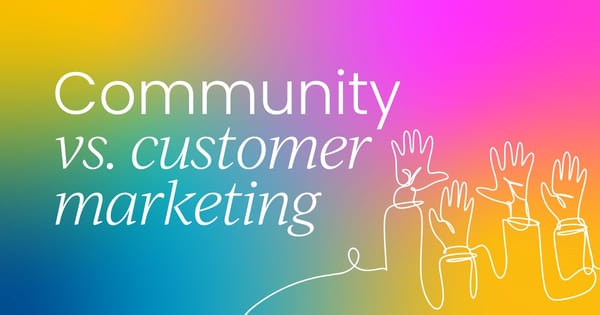Understanding the differences between customer marketing and community marketing can often feel like a “pot-ay-to” vs “pot-ah-to” situation. They’re both aiming for a lot of the same things, but reaching them in very different ways.
There’s a lot of overlap between the two strategies. For instance, both are used by businesses to put customer experience at the heart of what they do and focus on building long-lasting relationships with them. However, the way in which they achieve this is what sets them apart, plus the other goals they aim for will differ too.
It’s important to note that if you’re implementing a customer marketing strategy, you may also consider a community-based strategy as a factor in this, and vice versa. These can, and should, be complementary strategies. Still, as any customer marketer or community manager will tell you, it’s important to know the difference in order to achieve greatness from both.
What is customer marketing?
Customer marketing describes the type of strategy businesses will use to build and maintain meaningful relationships with their existing customers.
A hallmark of this strategy is measuring churn and retention. Customer marketers aim to reduce churn as much as possible while keeping a great level of customer retention. The ultimate goal is to increase customer loyalty, and drive repeat business in order to reduce the need for traditional marketing spend on new customers. More bang for your buck!
This will often be achieved through activities such as email marketing, loyalty programs, personalized promotions - pretty much anything that can assure the customer that the company is paying attention to them, and values their service.
Customer marketing encompasses strategic initiatives designed to nurture and strengthen relationships with your current customer base. Rather than solely pursuing new prospects, this approach prioritizes the valuable connections you've already established.
At its core, customer marketing centers on meaningful dialogue and genuine engagement. It involves actively listening to customer feedback, providing channels for open communication, and treating each interaction as an opportunity to deepen understanding and trust.
The foundation of effective customer marketing rests on three key pillars:
- Encouraging unwavering customer loyalty.
- Building authentic trust through consistent experiences.
- Transforming satisfied customers into enthusiastic brand advocates who naturally attract new business.
The process begins with retention, ensuring existing customers receive exceptional experiences that not only encourage repeat purchases but also inspire them to become vocal supporters of your brand. These satisfied customers then become powerful marketing assets, sharing their positive experiences and recommendations with their networks.
This dual-purpose approach creates a virtuous cycle: while you're strengthening bonds with current customers and increasing their lifetime value, you're simultaneously generating organic growth through their authentic endorsements and referrals.
As it’s another great way to make sure the customer feels valued, customer marketing teams will often also implement a community marketing strategy, or a business can bring in this team to work alongside customer marketers.
What is community marketing?
Community marketing, or community-led growth, is a strategy that focuses on building a community of customers or users around a brand, product, or service.
It typically involves engaging with customers through forums, community platforms, social media, and more, in order to create a sense of belonging and loyalty among community members.
The goal of community marketing is to enhance the customer experience by providing a space for customers to learn and interact with each other and to unite them around their shared passion for a product or brand.
The desired result will be turning them into brand advocates who will promote the brand to others and help to drive acquisition and retention.”
These strategies are not competing; in fact, there is often a lot of overlap. Ultimately, both strategies will look to put the customer first, be it in the individual sense or in terms of their position in a wider group.
5 main differences between customer marketing and community marketing
One of the main differences between customer marketing and community marketing is their focus. Customer marketing is focused on individual customers and their interactions with the brand, while community marketing is focused on building a sense of community and connection among customers.
Another key difference is the type of activities involved. Customer marketing often involves direct marketing efforts such as email campaigns, while community marketing often involves more indirect efforts such as hosting events and creating social media content.
To dig a little deeper, here are five of the main differences between customer marketing and community marketing.
Target audience
The target audience is one of the main differences between customer and community marketing. Customer marketing focuses on the individual customer and their needs, while community marketing focuses on the collective needs of a group of customers.
Objectives
The objective of customer marketing is to drive customer loyalty and repeat business, while the objective of community marketing is to build a strong and engaged community around a brand.
Tactics
Customer marketing tactics often include targeted promotions and offers, personalized communications, and loyalty programs, while community marketing tactics often include social media management, events, and content creation.
Success metrics
Customer marketing typically measures success through metrics such as customer lifetime value, repeat purchase rate, and customer satisfaction, while community marketing measures success through metrics such as engagement, advocacy, and community size.
Customer role
In customer marketing, the customer is seen as someone to be sold to, while in community marketing, the customer is seen as a valuable participant and contributor to the community. The focus is on creating a two-way relationship where the customer feels valued and engaged with the brand.
5 tips for community marketing and customer marketing collaboration
While customer marketing and community marketing are each rock-solid strategies in their own right, they can complement each other like macaroni and cheese - both versatile and important in their own right, but even more brilliant together.
Through collaboration, customer marketing teams can provide community marketing teams with valuable insights into customer behavior and preferences, while community marketing teams can provide customer marketing teams with valuable feedback on what is resonating with customers.
For example, customer marketing teams may use data from community marketing activities to create more targeted and personalized promotions for their customers.
Here are five clear-cut ways Customer Marketing Managers and Community Managers can collaborate to achieve the best possible outcome
Goal sharing and alignment
Customer and community marketing teams can work together by aligning their goals and objectives, ensuring they both support the overall vision and mission of the company.
Collaborative Planning
Both teams can come together to plan and execute marketing initiatives, leveraging each other's expertise and resources to maximize impact and efficiency.
Cross-promotion
Customer marketing can promote community engagement opportunities to its audience, while community marketing can highlight customer success stories to build trust and credibility.
Joint analytics
By sharing data and insights, both teams can gain a better understanding of customer behavior and preferences, enabling them to optimize their marketing efforts.
Campaign integration
Customer and community marketing teams can collaborate on integrated campaigns that bring together the best of both worlds, providing a unified experience for customers and creating a stronger connection with the brand.
In a nutshell
Customer and community marketing are two solid, increasingly popular strategies businesses can use to build and maintain relationships with their customers.
While there are key differences between the two, they can be complementary when used together. By working together, customer and community marketing teams can provide valuable insights and feedback that can lead to more effective marketing efforts and increased customer loyalty.


 5 min read
5 min read
 Follow us on LinkedIn
Follow us on LinkedIn



